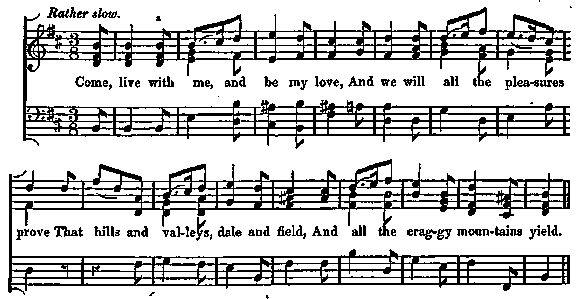Popular Music Of The Olden Time Vol 1
Ancient Songs, Ballads, & Dance Tunes, Sheet Music & Lyrics - online book
| Share page | Visit Us On FB |
|
ILLUSTRATING SHAKESPEARE. |
215 |
|||
|
six lines in each stanza; and " The woefull lamentation of Jane Shore," beginning, " If Rosamond that was so fair " (copies of -which are in the Pepys, Bagford, and Roxburgh© Collections), "to the tune of Live with me," has four lines and a burden of two— " Then maids and wives in time amend,
For love and beauty will have end." From this it appears that either the half of the tune was repeated, or that there were two airs to which it was sung. In Westminster Drollery, 1671 and 1674, a parody on Gome, live with me, is to the tune of My freedom is all my joy. That has also six lines, and the last is repeated.
Other ballads, like "A most sorrowful song, setting forth the miserable end of Banister, who betrayed the Duke of Buckingham, his lord and master: to the tune of Live with me ;" and the Life and Death of the great Duke of Buckingham, who came to an untimely end for consenting to the depositing of two gallant young princes," &c.: to the tune of Shore's Wife, have, like Come, live with me, only four lines in each stanza. (See Crown Garland of Golden Roses, 1612; and Evans' Old Ballads, iii. 18 and 23.) |
||||
|
|
||||
 |
||||
|
|
||||
|
There will we ait upon the rocks, And see the shepherds feed their flocks, By shallow rivers, to whose falls Melodious birds sing madrigals.
There will I make thee beds of roses, And twine a thousand fragrant posies; A cap of flowers, and a kirtle, Embroider'd all with leaves of myrtle. |
A gown made of the finest wool, Which from our pretty lambs we pull; Slippers lined choicely for the cold, With buckles of the purest gold.
A belt of straw and ivy buds, With coral clasps and amber studs: And if these pleasures may thee move, Come, live with me, and be my love. |
|||
|
|
||||
|
The shepherd swains shall dance and sing, For thy delight, each May. morning; If these delights thy mind may move, Then live with me, and be my love. |
||||
|
|
||||
|
* In Sir John Hawkins* copy, this note is written an octave lower, probably because taken from a lute arrangement, in which the note, being repeated, was to be played on a lower string. In the second bar of the melody, his |
copy, if transposed into this key, would be b a d, instead of b c d ; which latter seems right by the analogy of that and the other phrases, although the difference is not very material. |
|||